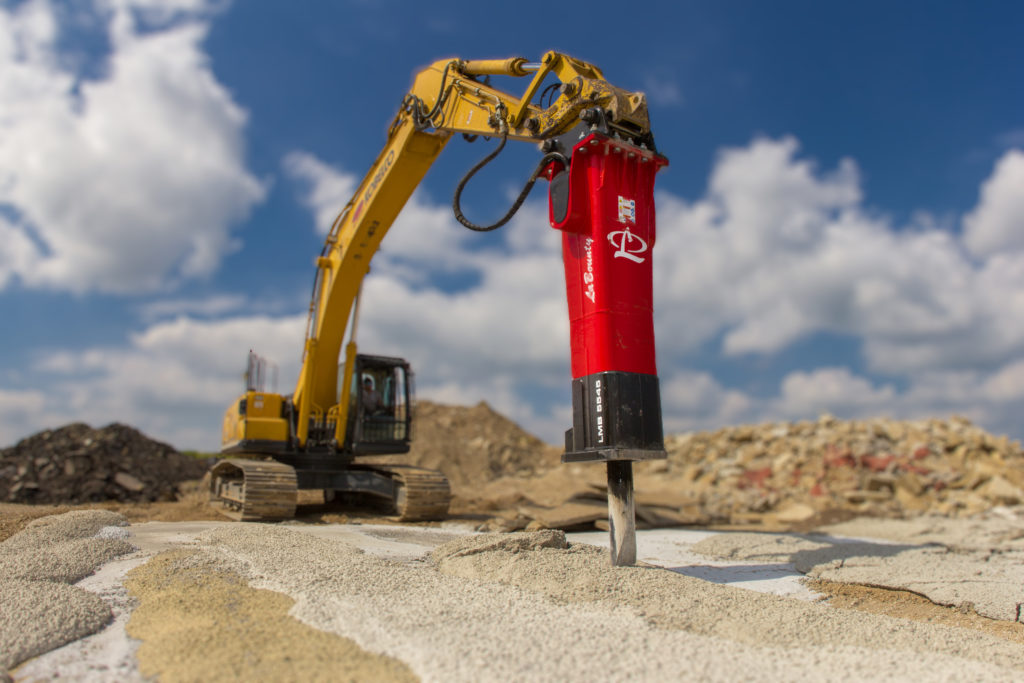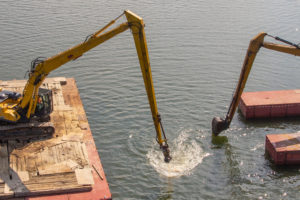Breaking Down Attachment Maintenance
With breakers and processors, proper use, maintenance and equipment pairings are critical to getting the most out of these versatile attachments.

Breakers and processors are two of the most common attachments found on demolition sites because of their versatility and ability to efficiently reduce material to a specific size. These attachments can perform primary and secondary demolition in a range of configurations.
Before renting or purchasing a breaker or processor, operators should evaluate several factors.
Carrier considerations
Operators should understand their carriers’ attachment weight capacity, working ranges and hydraulic capabilities.
The size of the breaker or processor is completely dependent upon the carrier’s attachment weight capacity; however, this capacity can be increased with a second-member installation of the breaker or processor. This means operators can use a larger attachment on a smaller machine to save on operating costs. Second-member attachments often are limited in their working ranges, so operators who require more reach still likely would need a third-member attachment installation.
The final carrier consideration is the machine’s hydraulic capabilities. Most carriers come standard with one-way directional flow that is required for breaker operation, but some processors require double-acting hydraulic circuits, which enable the attachment to open, close and rotate. Operators should check their machine’s spec sheet to see if their carrier has the proper hydraulic capabilities. If it does not, some heavy equipment dealerships employ expert technicians who can add the proper hydraulic plumbing.
Material size and PSI
Operators should understand the initial size of the material they will be working with, its compressive strength in pounds per square inch (PSI) and the desired end-product size. Breakers are used to hammer larger pieces of material using higher PSI.
Processors are limited to material that is small enough to fit in their jaws. They commonly are used in applications where precision is required or when material needs to be reduced to smaller sizes.
Attachment options and applications
For breakers, operators can use several different bits. The two most common are chisel and blunt bits. Chisel bits allow operators to control the way the material breaks, whereas blunt bits shatter material such as concrete slabs into more manageable sizes.
Breakers also can be attached to high-reach and long-reach excavators when a teardown does not require great precision. The breaker can demolish large pieces of a building in a few fires of the attachment. However, operators need to be acutely aware of the attachment size in these applications for efficient use.
“Operators will have to downsize the attachment due to the additional length involved in the stick and the boom,” Jon Noll, fleet manager at Company Wrench, Carroll, Ohio, says. “For example, on a 50- to 60-foot-high reach, we downsize the breaker to a 3,000-foot-pound hammer. On the long reaches, which are 72 and 79 feet, we downsize the attachment to a 1,500-foot-pound hammer.”
Breakers also can be used in underwater applications, such as hammering rock in a trench near a riverbed. In these cases, an underwater kit is needed. The underwater kit uses a pressure switch and air compressor to ensure water does not damage important components on the breaker.
Processors have a wide range of options, as well, including mobile demolition processors, mobile hydraulic pulverizers and universal processors. Each of these attachments offers unique advantages.
Mobile demolition processors specialize in primary demolition projects. These attachments are frequently found in high-reach applications because of their crushing power and ability to operate at multiple angles. This attachment also enables operators to cut rebar as they are demolishing a building, which saves an additional processing step later.
Mobile hydraulic pulverizers are used for processing secondary demolition materials. This attachment is not reliant on the excavator’s bucket cylinder for processing, which allows it to have a greater crushing force. Most mobile hydraulic pulverizers do not feature rotation because they are purpose-built to process material at ground level.
Universal processors can use multiple jaw sets to cut various types of material. A universal processor can be fitted with a shear jaw to cut scrap, a concrete cracker jaw to crush concrete or a pulverizing jaw for primary and secondary demolition.
“Universal processors are seen as a Swiss Army Knife,” Company Wrench Fleet Support Product Trainer Ben Dowdy says. “It’s great for operators who want to use only one attachment for multiple applications.”
Workers should try to avoid several mistakes when operating a breaker or processor.
For breakers, prying is one of the leading issues. Prying occurs when operators are hammering material and the bit gets stuck. To dislodge the bit, operators will move the attachment back and forth or pry it. This can cause the bit to snap because it is not designed to flex.
Another common mistake is firing the breaker for too long. According to most industry experts, operators should only fire for 15 to 20 seconds before giving the attachment a break to cool down and for grease to circulate to important components of the breaker.
“When operators fire for too long, it burns up the bit [and] bushings, and all of the heat transfers up through the cell, burns up the seals and, eventually, we’ll start seeing damage on the pistons, as well,” Noll says. “This can cause tens of thousands of dollars in damages in some cases.”
One of the most frequent mistakes with processors involves sideloading, which causes damage to the bearing that allows the attachment to rotate. Sideloading is caused by misuse, such as pulling, prying and ripping material.
“The rotation feature of a processor is only designed to put the attachment in place,” Dowdy says. “Oftentimes we see operators try to use it to pry material at a certain angle from a structure. That will cause damage to the attachment.”
Maintenance requirements
Maintenance requirements for breakers consist of applying chisel paste to avoid damage to the attachment’s bushings and reading the operator’s manual for bit wear recommendations. Most modern breakers come with a self-contained greasing unit that circulates chisel paste as the attachment operates. Operators should make sure the grease tubes have the proper amount of grease and that the hoses are not damaged prior to use.
Processors also require daily greasing of key components. Most manufacturers suggest 10 hours of maintenance for every 40 hours of operation. This allows operators to address minor wear or damage before it causes costly downtime. Operators can contact the manufacturer or the dealership to determine best practices for their attachments. Some dealerships also can provide an additional layer of protection.
“We add high abrasive protection—we call them chalky bars—that lengthens the life of the attachment,” Dowdy says. “The high abrasive protection allows operators to avoid putting unnecessary wear on the attachment. This saves time and money on the maintenance of the attachment, as well. We can simply cut off the remaining high abrasive material and weld new material on rather than having to perform a full attachment buildup.”
This story also appears in Construction & Demolition Recycling magazine.


